
by Mary E. Clayton, Jill B. Kjellsson and Michael E. Webber Thursday, October 2, 2014
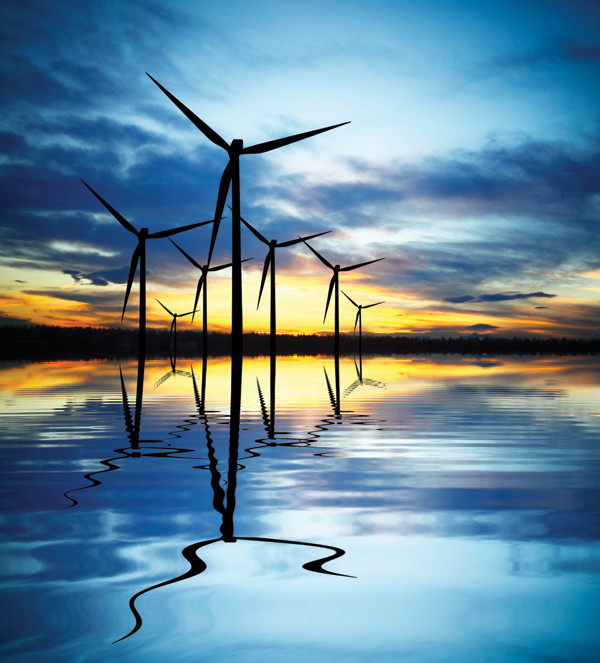
Credit: ©Shutterstock.com/Pati Photo.
Over the past four years, a record-setting drought has impacted Texas, the second-most populous state in the U.S. The drought started in October 2010, and 2011 was the driest year on record for Texas, with an average of less than 40 centimeters of rain falling across the state. Today, more than 60 percent of the state is still experiencing some degree of drought, leaving reservoirs less than two-thirds full and impacting more than 15 million people. Stories of dry riverbeds and cities using their wastewater as a source for drinking water fill the headlines. Meanwhile, the state has continued to grow faster than all but two other parts of the U.S. (North Dakota and the District of Columbia), and electric grid operators worry about meeting demand.
Texas has tremendous resources, including natural gas, oil, solar and wind — the state produces the most wind power in the U.S. — but due to the epic drought and population growth, the energy system and water resources are strained. However, there might be a way to improve both the state’s energy and water woes at once — by removing the salts from brackish groundwater using solar and wind power.
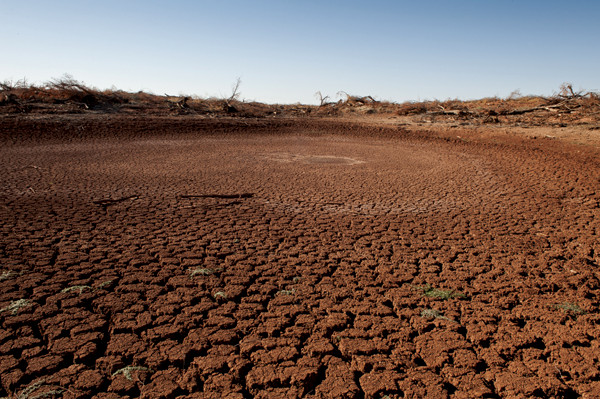
A record-setting drought has impacted Texas since October 2010; 2011 was the driest year on record. Credit: ©Shutterstock.com/Ann Worthy.
Texas isn’t the only location where desalination could work. Many areas of the United States — and the world — are facing or will likely soon face water constraints, due to increasing demands for water, decreasing water supplies and increases in the frequency and severity of droughts.
Water-scarce regions are considering or already using expensive and far-flung water sources — employing everything from long-haul pipelines to move rivers hundreds of kilometers from source to city, to building giant refrigeration systems that condense water out of the sky. That means the electricity demand to produce, pump and treat new water supplies — which are often harder to get because they are deeper, dirtier or farther away — will only exacerbate the electric grid’s ongoing challenges.
Electric grids are already straining to meet surging demand for power as temperatures rise and people install more and more electrical devices and appliances every day. Traditional thermal power plants, meanwhile, rely on water to run. And treating and transporting water for human consumption relies on electricity.
Water and energy are inextricably linked, and both sources are confronting limits. However, by taking advantage of synergistic geographical overlaps of hydrological, geological and energy resources — for example, wind and solar resources located above abundant brackish groundwater — to create an integrated water supply, we might solve several problems at once, not just in Texas, but around the world.
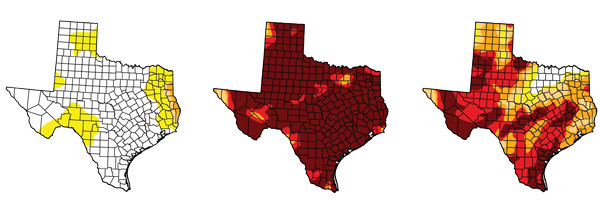
From left to right: Drought impacts in Texas, by county and severity — darker reds indicate more severe drought — in October 2010, October 2011 and February 2012. Credit: Drough Monitor.
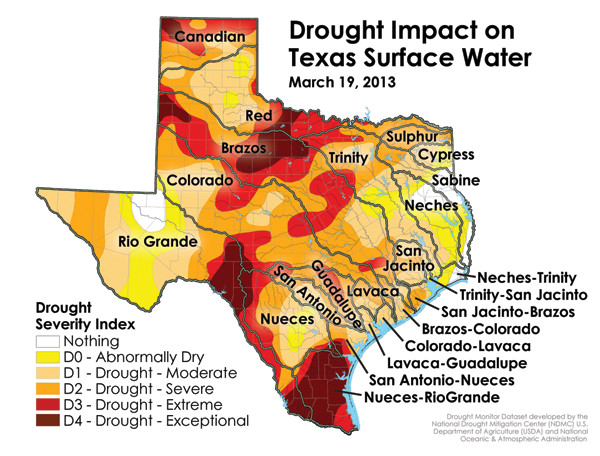
Drought is still affecting most of the state. The drought has also impacted surface water reserves (large map). Credit: Drought Monitor.
Because Texas has an abundance of brackish groundwater, sunshine and wind, our team analyzed the potential of using wind- and solar-generated power to desalinate brackish groundwater in every single county in the state.
Brackish groundwater has total dissolved solids, or salts, between 1,000 and 10,000 milligrams per liter, which makes it saltier than freshwater but less salty than seawater. And it is prevalent throughout much of Texas; according to the Texas Water Development Board, approximately 10,000 wells encounter brackish water at depths between zero and 2,225 meters. The total volume of brackish groundwater in Texas is estimated to be about 2.7 billion acre-feet (or 880 trillion gallons) — enough, if it were cleaned and desalinated, to meet the household water needs for every Texan for more than 700 years. Concerns about withdrawals of brackish groundwater negatively impacting freshwater sources are mostly relevant in Gulf Coast regions of the state, where drawing freshwater from wells sometimes pulls brackish water and saltwater inland from near the Gulf. Thankfully, there are aquifers with better potential for brackish groundwater withdrawal that would have less impact on freshwater sources because there is a reasonable distance between water layers with material separating them.
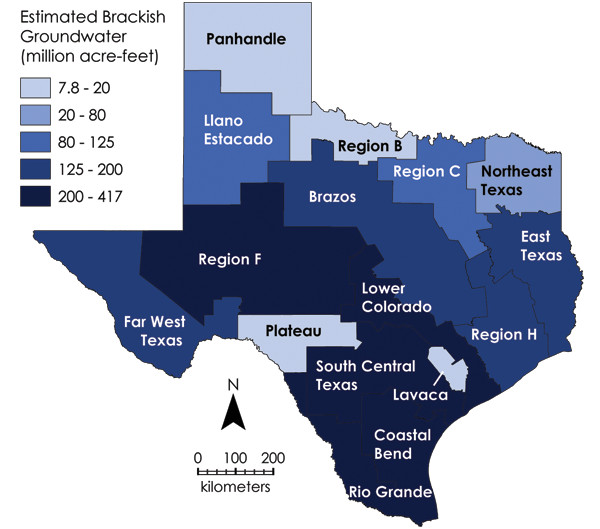
Brackish groundwater is prevalent throughout the state of Texas. Credit: Clayton, Kjellsson and Webber.
Generally, competition for access to brackish groundwater doesn’t exist as it is unusable even for agricultural irrigation. And, in fact, Texas already gets 166 million cubic meters of usable water per year (120 million gallons per day) from brackish water desalination using conventional power sources such as coal and natural gas at 44 brackish water desalination facilities. Although that might sound like a lot of water, it’s only about 1 percent of total statewide consumption.
Brackish groundwater desalination takes an estimated three to 10 times as much energy to prepare for human use as surface water because it requires energy to pump the water to the surface and then remove the salts. The energy intensity of the resource is a function of the depth to the brackish groundwater source and the source’s water quality — its concentration of total dissolved solids, which varies across the state. Nonetheless, brackish water is a whole lot less salty — and therefore less energy-intensive — to desalinate than seawater. And if you do not have surface freshwater in the first place, then it might be an appealing option. As an Arabian proverb says, “In the desert, any water will do.”
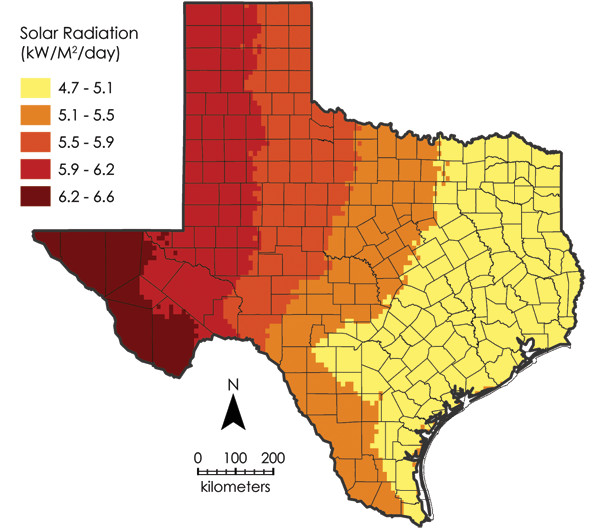
Plentiful solar insolation experienced throughout Texas makes the state a suitable location for solar power installations. Credit: Clayton, Kjellsson and Webber.
Texas also has abundant wind and solar energy resources. With a push toward renewable electricity standards and existing production tax credits for wind-generated electricity, the last decade has witnessed substantial growth in wind power generation particularly. Wind power comprised 43 percent of new electricity-generating capacity in the U.S. in 2012. And of the 60,000 megawatts of installed wind-generation capacity in the country at the end of 2012, Texas led the way with 12,200 megawatts.
Texas is also the lowest-cost region for installed projects, according to the Department of Energy. Wind power projects are economically constrained to areas with reliable and adequate wind speeds. Typically, wind speeds greater than 5 meters per second, known as “Class 3” (or higher), are considered suitable for utility-scale wind power. That is, of course, subject to change, if electricity prices rise, or if costs for wind turbines fall. At current classifications, West Texas and the Panhandle have a wind power classification of 3 or greater, making this a great location for wind turbine installations. More areas of Texas could be considered suitable for wind power generation if the costs change.
Texas also has abundant solar potential, which increases as you move from east to west across Texas and during the summer months when solar insolation, and therefore electricity production, is at its peak.
Putting these three concepts together, we found substantial geographic overlap between areas with abundant wind, solar radiation and brackish groundwater. Areas such as Abilene in west-central Texas have especially high potential. But integrating these three factors is the challenge.
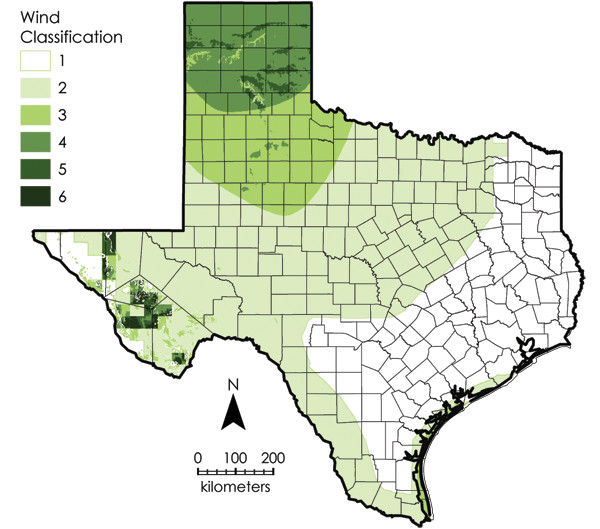
Wind classification considered to be suitable for utility- scale wind exists in the panhandle regions of Texas. Credit: Clayton, Kjellsson and Webber.
We evaluated the technical potential and geographic feasibility of integrating wind and solar with a brackish groundwater desalination facility.
We found that in areas with a lot of wind and solar resources, large volumes of shallow and mildly brackish groundwater, and high local water prices, an integrated system has high potential to improve the supply of water and electricity and could be more profitable than a standalone power plant.
An integrated facility would require a large up-front capital investment. But it would be more flexible as a standalone plant, as it could produce electricity and water, and it would be more efficient overall. Plant operators would benefit by hedging the power and water markets, selling whichever commodity is most profitable at that particular moment depending on the particular market and pricing conditions. An integrated plant would sell water when water prices are high and would sell electricity when electricity prices are high, and could easily store water when conditions are mediocre. That’s especially useful as a way to capture intermittent, off-peak electricity from wind power.
Our analysis indicates that it would be profitable to desalinate brackish groundwater using wind-generated electricity in the cities of Abilene, Lubbock and Midland, serving hundreds of thousands of people in these three cities combined. If water prices rise, then this approach would be an economical way to serve millions more people.
Texas’ abundance of brackish groundwater, sunshine and wind located in many of the same areas makes it ideal for this kind of integration. But it isn’t unique: Many arid parts of the world have this fortuitous co-location of resources, so if the strategy could work in Texas, it could work elsewhere too. But challenges remain.
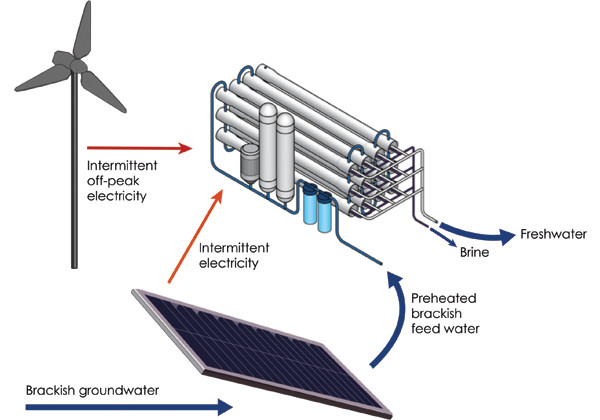
The utilization of wind and solar power generation technologies for desalination of brackish groundwater presents an opportunity to transform low-value products (brackish groundwater, intermittent and off-peak electricity, and waste heat) into a high-value product (treated drinking water). Credit: Clayton, Kjellsson and Webber.
Desalination of brackish water using reverse osmosis, the most common desalination membrane treatment process, consumes approximately 10 times as much energy per unit of water as traditional surface-water treatment. However, improvements in desalination technologies — such as newer membranes that are not as vulnerable to fouling, and systems that capture waste heat from nearby devices — coupled with increasing demand for water have resulted in significant growth in interest and implementation of desalination projects around the world. By some estimates, global desalination capacity is expected to more than double between 2010 and 2020.
A seemingly independent issue faced by resource planners, electric grid managers and policymakers is the variability associated with large-scale integration of wind and solar power into the electricity grid. Currently, the intermittent nature of wind and solar resources does not allow operators to dispatch wind and solar power to meet load as consistently as they can with conventional baseload power plants.
This intermittency is both predictable — the sun not shining at night, for example — and unpredictable, such as that due to sudden weather changes. Inland wind is often out of phase with demand: When electricity demand is highest in the afternoons, winds tend to be weakest, and when electricity demand is lowest at night, wind speeds peak. Similarly, inland wind resources are weakest in the summer, when electricity demands are highest, and strongest in the winter and shoulder months, when electricity demands are typically lower. Although solar resource availability typically matches more closely with electricity demand, some energy storage or demand reduction mechanism would be needed to meet demand with large amounts of solar power on the grid.
Another challenge faced by wind and solar implementations is the requirement of substantial electricity transmission infrastructure that is time-intensive and expensive to construct, as wind and solar farms are often located far from population centers. Additionally, the high capital costs of wind turbines and the lower prices for electricity in the middle of the night reduce profitability for wind farms. The potential expiration of the renewable tax credits could further limit profitability of wind and solar power. These tax credits are perpetually on the chopping block, although Congress has often saved them at the last minute.
In addition, planners and policymakers have stated that energy storage technologies must be developed to make electricity produced during periods of low demand available during periods of higher demand and/or to dampen fluctuations in output. This last challenge could be directly met by using wind and solar power to desalinate brackish groundwater.
Storing desalinated water could act as a proxy for energy storage: For one thing, it is a lot cheaper and easier to store water than it is to store electricity. Instead of expensive lithium-ion batteries, for example, you can simply dig reservoirs or use holding tanks.

Research suggests it would be especially profitable to desalinate brackish groundwater using wind-generated electricity in the cities of Abilene, Lubbock and Midland, serving hundreds of thousands of people. Credit: ©Shutterstock.com/Spirit of America.
One of the major benefits of coupling desalination with renewable energy sources is that it allows for freshwater production without increasing dependence on carbon-emitting fuel sources. Integrating wind and solar power with brackish groundwater desalination thus presents an opportunity to transform low-value products (saline groundwater and intermittent electricity) into a high-value product (treated drinking water).
We also found that by using wind and solar energy to desalinate brackish groundwater, the water sector could help solve some of the power sector’s problems, while the power sector simultaneously helps solve some of the water sector’s problems. The flexibility in the operation of desalination plants — whose production can be dialed up or down on command — could solve the intermittency issues of wind and solar by treating the water plant as a load that is able to match electricity provided by the wind and solar when they are available. When the wind is blowing, run the desalination plant at full-bore; when wind is slow, turn down the desalination efforts. The power sector typically turns supply from power plants up or down to match consumption, but with this integrated desalination plant, the consumption can be dialed up or down to match the supply of electricity.
And the low marginal cost and cleanliness of wind and solar could solve the cost, energy requirements and carbon intensity of desalination.
Additionally, because groundwater is typically cooler than surface conditions — at least in Texas and some other areas that fit the criteria we’ve outlined — it could be used to cool solar panels, thus improving their efficiency. In the process of cooling the solar panels, the brackish water is heated, which improves its membrane throughput and recovery during the desalination process. It is a win-win scenario, with both water and electricity being produced with higher efficiency.
After examining the situation in Texas, we conclude that integrating energy and water systems has the potential to yield more reliable supply and lower costs for both sectors — and this could apply in many different locations. There is a lot of wind, sunshine and brackish water around the world. By coordinating their use, we can make all of them more valuable.
All maps are from http://droughtmonitor.unl.edu
© 2008-2021. All rights reserved. Any copying, redistribution or retransmission of any of the contents of this service without the expressed written permission of the American Geosciences Institute is expressly prohibited. Click here for all copyright requests.